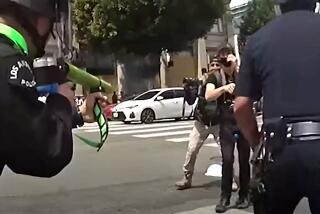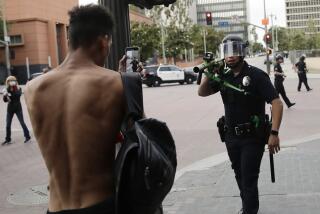LAPD Manual Doesnât Bar Flashlight as Weapon
The Los Angeles Police Departmentâs manual on procedures runs to 636 pages and covers everything from chokeholds to the type of belts officers must wear, but it includes no specific mention of using flashlights to subdue suspects.
Nor does the department train its officers in how to wield a flashlight.
Thatâs the weapon that an LAPD officer was videotaped using last week to strike 36-year-old Stanley Miller 11 times after a car chase.
Departments in New York, Chicago and Detroit have severely restricted use of flashlights as weapons and, in some cases, have equipped officers with smaller, lighter flashlights.
Now, LAPD Chief William J. Bratton has ordered his department to review the authorized use of flashlights to subdue suspects, saying last weekâs incident looked âawful, quite frankly.â
Deputy Chief Michael Berkow said Tuesday that the LAPD would examine the âbest practices around the countryâ to draw up a specific policy.
In recent years, many of the largest urban police departments have moved to prohibit the use of flashlights as weapons in most circumstances, out of concern that the heavy metal objects could cause more serious injuries than batons.
By contrast, Assistant Chief George Gascon said LAPD officers were allowed to wield a flashlight as an âimpact weaponâ with aggressive or combative suspects, but only when a baton was not available and only for defensive purposes.
âThe flashlight is not the tool of choice,â he said.
So far this year, the LAPD has recorded seven use-of-force incidents involving flashlights. In 2003, it reported 15, down from 24 in 2002.
All of those cases were considered ânon-categorical use of force,â meaning the blows were not administered to a suspectâs head or were not likely to cause life-threatening injury, LAPD officials said. In the last three years, the officials said, there have been only a handful of âcategorical use-of-force casesâ -- those that could cause death.
LAPD officers are allowed to choose the kind of flashlight they use on patrol, and many opt for the large metal type that can potentially be a lethal weapon, department officials said.
A year ago, a special counsel working for the Los Angeles County Board of Supervisors reported that sheriffâs deputies were employing their flashlights more than twice as often as their batons to strike suspects. He recommended that the Sheriffâs Department halt the use of flashlights as weapons in all but exceptional circumstances, but the department has not followed the suggestion.
In a 1999 study of six urban police jurisdictions across the nation, flashlights were second only to chemical Mace as the most frequently employed weapon, the study concluded.
Officers were more than twice as likely to use a flashlight as a weapon as they were their baton, the National Institute of Justice study found, the same level of use found among Los Angeles County sheriffâs deputies.
But Christopher Maxwell, an associate professor at Michigan State Universityâs School of Criminal Justice and one of the authors of the study, said police departments across the nation had been switching to smaller plastic and metal flashlights.
The Miller beating is not the first time that police use of a flashlight as a weapon has drawn attention. In a high-profile Ventura County case, 21-year-old college student Nicholas Dowey was hit in the head with a bat or club by an assailant at a 1997 party. Dowey died, and his family claimed that deputies had aggravated his injuries by hitting him in the head with a flashlight during a struggle.
The danger of using flashlights rather than batons was highlighted as far back as 1985, in a study in the Journal of Police Science and Administration. It said flashlights were more likely to cause injury than batons.
âIf the flashlight is swung such that it strikes the skull at an angle, the possibility of a fracture of the skull is very likely and almost a certainty if the blow is delivered near the eye socket or the temporal region of the head,â the study concluded.
The New York Police Department, the nationâs largest, prohibits officers from using flashlights or radios as âimpact weaponsâ except in life-and-death situations.
Bratton headed that department from 1994 to 1996.
In 1995, Detroitâs police chief barred officers from carrying large flashlights, specifically any metal flashlight that used C- or D-cell batteries.
The decision came two years after the fatal flashlight beating of motorist Malice Green by two officers who were subsequently convicted in his death. The city paid Greenâs family $5.2 million.
The Chicago Police Department changed its policies on flashlights in 1998 after litigation, department spokesman Patrick Camden said.
Chicago officers are prohibited from using or having in their possession any flashlight made of metal or metal alloy except for a small AA-battery flashlight, Camden said. Their official flashlight is now a lightweight plastic model about 6 inches long and half an inch in diameter.
Connie Rice, a civil rights attorney heading a commission looking into the LAPDâs handling of the Rampart corruption scandal, cautioned that banning the use of flashlights as weapons was not the answer.
âItâs not the tool thatâs the problem; itâs how itâs used and when itâs used thatâs the problem that goes to the departmentâs use-of-force culture,â she said. âThey shoot people at the wrong time, but you donât take away their guns. You train them how to operate under the extreme pressure of losing your life and how to make those split-second decisions better.â
In the L.A. area, law enforcement policies on flashlights vary.
Long Beach police are allowed to use a flashlight as though it were a baton, said Sgt. David Cannan. âThere are times when you have it in your hand and, if you get into a scenario where you have to use force, you use it,â he said.
Pasadena officers may use flashlights in self-defense or to subdue a suspect when there is no other weapon available, said spokeswoman Janet Pope, adding that the department lets officers choose their own flashlights.
Los Angeles County sheriffâs deputies have received training in the use of flashlights -- limited by regulations to weighing a little more than a pound -- for more than a decade, said Lt. Roy Levario of the training bureau. And the department spells out some of those policies in a supplemental manual on defensive tactics.
âThe flashlightâs primary purpose is illumination, but it becomes a defensive weapon of necessity,â he said. âAs with other tools such as a baton, deputies are trained in the use of flashlights ... and how to control suspectsâ with them.
Levario could not provide statistics on how often flashlights were employed as impact weapons but said the number of those incidents had dropped recently because deputies were increasingly using pepper spray and Tasers to subdue suspects.
As recently as February 2003, however, the use of flashlights as weapons was prevalent enough that Merrick Bobb, the special counsel for county supervisors, reported that they were used twice as often as batons.
From December 1997 to December 2002, Bobb found, flashlights were used 231 out of 365 times when a suspect was struck with an impact weapon, or in 63% of the cases. In contrast, batons were used 93 times, or in 25% of the cases.
Sheriff Lee Baca said he had not curbed flashlight use because he believed it better to govern when and how to use force rather than which tool to use.
âIf you take away flashlights completely, what do you do if you donât have a gun?â he said. âWe have a pretty aggressive policy when it comes to limiting force. We have a no-head-strike policy except in life-and-death situations. If a use of force is not reasonable and necessary, it is out of policy, and discipline will be forthcoming.â
More to Read
Sign up for Essential California
The most important California stories and recommendations in your inbox every morning.
You may occasionally receive promotional content from the Los Angeles Times.











